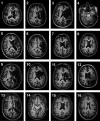Different patterns of language activation in post-stroke aphasia are detected by overt and covert versions of the verb generation fMRI task
- PMID: 22367124
- PMCID: PMC3319663
- DOI: 10.12659/msm.882518
Different patterns of language activation in post-stroke aphasia are detected by overt and covert versions of the verb generation fMRI task
Abstract
Background: Post-stroke language functions depend on the relative contributions of the dominant and non-dominant hemispheres. Thus, we aimed to identify the neural correlates of overt and covert verb generation in adult post-stroke aphasia.
Material and methods: Sixteen aphasic LMCA stroke patients (SPs) and 32 healthy controls (HCs) underwent language testing followed by fMRI while performing an overt event-related verb generation task (ER-VGT) isolating activations related to noun-verb semantic processing or to articulation and auditory processing, and a covert block design verb generation task (BD-VGT).
Results: BD-VGT activation patterns were consistent with previous studies, while ER-VGT showed different patterns in SPs relative to HCs including less left-hemispheric involvement during semantic processing and predominantly right-sided activation related to articulation and auditory processing. ER-VGT intra-scanner performance was positively associated with activation during semantic associations in the left middle temporal gyrus for HCs (p=0.031) and left middle frontal gyrus for SPs (p=0.042). Increased activation in superior frontal/cingulate gyri was associated with better intra-scanner performance (p=0.020). Lesion size negatively impacted verbal fluency tested with Controlled Oral Word Association Test (p=0.0092) and the Semantic Fluency Test (p=0.033) and trended towards a negative association with verb generation performance on the event-related verb generation task (p=0.081).
Conclusion: Greater retention of pre-stroke language skills is associated with greater involvement of the left hemisphere with different cortical recruitment patterns observed in SPs versus HCs. Post-stroke verbal fluency may depend more upon the structural and functional integrity of the dominant left hemisphere language network rather than the shift to contralateral homologues.
Figures



Similar articles
-
Females and males are highly similar in language performance and cortical activation patterns during verb generation.Cortex. 2012 Oct;48(9):1218-33. doi: 10.1016/j.cortex.2011.05.014. Epub 2011 May 26. Cortex. 2012. PMID: 21676387 Free PMC article.
-
Recovered vs. not-recovered from post-stroke aphasia: the contributions from the dominant and non-dominant hemispheres.Restor Neurol Neurosci. 2013;31(4):347-60. doi: 10.3233/RNN-120267. Restor Neurol Neurosci. 2013. PMID: 23482065 Free PMC article.
-
Contribution of the left and right inferior frontal gyrus in recovery from aphasia. A functional MRI study in stroke patients with preserved hemodynamic responsiveness.Neuroimage. 2010 Jan 1;49(1):885-93. doi: 10.1016/j.neuroimage.2009.08.057. Epub 2009 Sep 4. Neuroimage. 2010. PMID: 19733673
-
Mechanisms of recovery from aphasia: evidence from positron emission tomography studies.J Neurol Neurosurg Psychiatry. 1999 Feb;66(2):155-61. doi: 10.1136/jnnp.66.2.155. J Neurol Neurosurg Psychiatry. 1999. PMID: 10071093 Free PMC article.
-
The role of language-related functional brain regions and white matter tracts in network plasticity of post-stroke aphasia.J Neurol. 2024 Jun;271(6):3095-3115. doi: 10.1007/s00415-024-12358-5. Epub 2024 Apr 12. J Neurol. 2024. PMID: 38607432 Review.
Cited by
-
Emerging Validation for the Adapted Chinese Version of Quick Aphasia Battery.J Multidiscip Healthc. 2023 Aug 30;16:2557-2566. doi: 10.2147/JMDH.S417810. eCollection 2023. J Multidiscip Healthc. 2023. PMID: 37667799 Free PMC article.
-
Induction of neuroplasticity and recovery in post-stroke aphasia by non-invasive brain stimulation.Front Hum Neurosci. 2013 Dec 24;7:888. doi: 10.3389/fnhum.2013.00888. Front Hum Neurosci. 2013. PMID: 24399952 Free PMC article. Review.
-
Neuroimaging Correlates of Post-Stroke Aphasia Rehabilitation in a Pilot Randomized Trial of Constraint-Induced Aphasia Therapy.Med Sci Monit. 2017 Jul 18;23:3489-3507. doi: 10.12659/msm.902301. Med Sci Monit. 2017. PMID: 28719572 Free PMC article. Clinical Trial.
-
Lesion correlates of auditory sentence comprehension deficits in post-stroke aphasia.Neuroimage Rep. 2022 Mar;2(1):None. doi: 10.1016/j.ynirp.2021.100076. Neuroimage Rep. 2022. PMID: 35243477 Free PMC article.
-
The Calculation of Language Lateralization Indices in Post-stroke Aphasia: A Comparison of a Standard and a Lesion-Adjusted Formula.Front Hum Neurosci. 2016 Oct 13;10:493. doi: 10.3389/fnhum.2016.00493. eCollection 2016. Front Hum Neurosci. 2016. PMID: 27790102 Free PMC article.
References
-
- Tatemichi TK, Desmond DW, Paik M, et al. Clinical determinants of dementia related to stroke. Ann Neurol. 1993;33(6):568–75. - PubMed
-
- Laska AC, Hellblom A, Murray V, et al. Aphasia in acute stroke and relation to outcome. J Intern Med. 2001;249(5):413–22. - PubMed
-
- Lazar RM, Speizer AE, Festa JR, et al. Variability in language recovery after first-time stroke. J Neurol Neurosurg Psychiatry. 2008;79(5):530–34. - PubMed
Publication types
MeSH terms
Grants and funding
LinkOut - more resources
Full Text Sources
Medical

